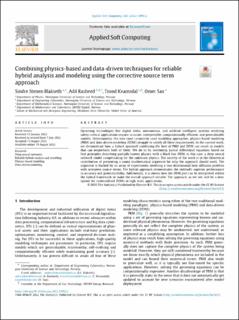| dc.contributor.author | Blakseth, Sindre Stenen | |
| dc.contributor.author | Rasheed, Adil | |
| dc.contributor.author | Kvamsdal, Trond | |
| dc.contributor.author | San, Omer | |
| dc.date.accessioned | 2022-09-19T13:57:09Z | |
| dc.date.available | 2022-09-19T13:57:09Z | |
| dc.date.created | 2022-06-08T03:33:10Z | |
| dc.date.issued | 2022 | |
| dc.identifier.citation | Applied Soft Computing. 2022, 128, 109533. | en_US |
| dc.identifier.issn | 1568-4946 | |
| dc.identifier.uri | https://hdl.handle.net/11250/3018976 | |
| dc.description.abstract | Upcoming technologies like digital twins, autonomous, and artificial intelligent systems involving safety–critical applications require accurate, interpretable, computationally efficient, and generalizable models. Unfortunately, the two most commonly used modeling approaches, physics-based modeling (PBM) and data-driven modeling (DDM) struggle to satisfy all these requirements. In the current work, we demonstrate how a hybrid approach combining the best of PBM and DDM can result in models that can outperform both of them. We do so by combining partial differential equations based on first principles describing partially known physics with a black box DDM, in this case, a deep neural network model compensating for the unknown physics. The novelty of the work is in the theoretical contribution of presenting a sound mathematical argument for why the approach should work. The argument is backed by an array of experiments involving a two-dimensional heat diffusion problem with unknown source terms. The hybrid approach demonstrates the method’s superior performance in accuracy and generalizability. Additionally, it is shown how the DDM part can be interpreted within the hybrid framework to make the overall approach reliable. The approach, as we see, will be a door opener for underutilized DDMs in high stake applications. | en_US |
| dc.language.iso | eng | en_US |
| dc.publisher | Elsevier | en_US |
| dc.rights | Navngivelse 4.0 Internasjonal | * |
| dc.rights.uri | http://creativecommons.org/licenses/by/4.0/deed.no | * |
| dc.subject | Deep neural networks | en_US |
| dc.subject | Reliable hybrid analysis and modeling | en_US |
| dc.subject | Physics-based modeling | en_US |
| dc.subject | Data-driven modeling | en_US |
| dc.title | Combining physics-based and data-driven techniques for reliable hybrid analysis and modeling using the corrective source term approach | en_US |
| dc.title.alternative | Combining physics-based and data-driven techniques for reliable hybrid analysis and modeling using the corrective source term approach | en_US |
| dc.type | Peer reviewed | en_US |
| dc.type | Journal article | en_US |
| dc.description.version | publishedVersion | en_US |
| dc.rights.holder | © 2022 The Author(s) | en_US |
| dc.source.pagenumber | 20 | en_US |
| dc.source.volume | 128 | en_US |
| dc.source.journal | Applied Soft Computing | en_US |
| dc.identifier.doi | 10.1016/j.asoc.2022.109533 | |
| dc.identifier.cristin | 2030101 | |
| dc.relation.project | Norges forskningsråd: 313909 | en_US |
| dc.relation.project | Norges forskningsråd: 308823 | en_US |
| dc.relation.project | Norges forskningsråd: 304843 | en_US |
| dc.source.articlenumber | 109533 | en_US |
| cristin.ispublished | true | |
| cristin.fulltext | original | |
| cristin.qualitycode | 2 | |

